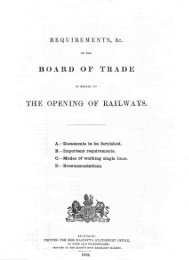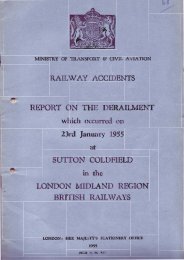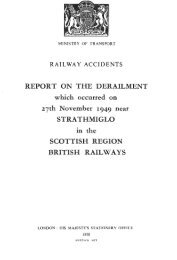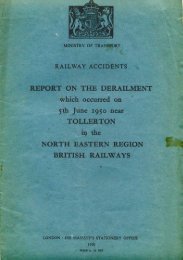R A I LT R AC K - The Railways Archive
R A I LT R AC K - The Railways Archive
R A I LT R AC K - The Railways Archive
Create successful ePaper yourself
Turn your PDF publications into a flip-book with our unique Google optimized e-Paper software.
Route characteristics<br />
DESCRIPTION This is principally a four-track railway but with some critical twoand<br />
three-track sections. Linespeed on the main lines is 100–110mph, while on<br />
the slow lines from London to Bedford it is 90mph. Elsewhere, linespeeds on the<br />
slow lines are restricted to 50–60mph. <strong>The</strong> south end of the route forms part of<br />
the Thameslink network. <strong>The</strong> route operates near to capacity between Luton<br />
and London.<br />
<strong>The</strong> key Midland Main Line investment comes to fruition in May 1999, with<br />
the introduction of new rolling stock and associated infrastructure improvements<br />
which will enable Midland Main Line to double train services.<br />
BOTTLENECK ANALY S I S<br />
Kentish T own–Luton <strong>The</strong> mix of fast and stopping services and varied station<br />
stopping patterns lead to a very high utilisation of the available capacity of this<br />
four track railway. In May 1999, the number of Midland Main Line services over<br />
the route will be increased from two to four trains per hour. This can be<br />
accommodated by the existing infrastructure except at Bedford where a new<br />
platform on the down fast line is currently being constructed and will be<br />
completed in May 1999. At St Pancras, we are also reinstating Platform 6 which<br />
is currently not in use .<br />
Route vision<br />
Our vision for the Midland Main Line is of a high-performance route providing<br />
motorway-competitive journey times with capacity increases to meet passenger<br />
growth. Linespeed improvements will be implemented to gain full benefit from<br />
the network and modern rolling stock.<br />
<strong>The</strong> Thameslink 2000 project will develop and expand the successful<br />
Thameslink network, providing direct links with greater capacity between this<br />
route across London to the South Coast.<br />
New stations at Luton Airport and the proposed East Midlands Parkway<br />
will substantially improve road-based accessibility to the route.<br />
Route development and customer requirements<br />
We have consulted with our customers, the passenger and freight train<br />
operators, to determine their needs and how we evaluate them. <strong>The</strong> proposals<br />
set out in these pages address our intentions to deliver their aspirations for<br />
service frequency, journey-time reductions, station and depot facilities and new<br />
rolling stock.<br />
We will also examine options to improve capacity, including remodelling<br />
of junctions and the provision of additional platforms and crossovers to remove<br />
bottlenecks from the route and allowing journey-time improvements in line<br />
with current operator aspirations. Linespeed improvements are being<br />
considered at a number of locations and will be achieved in 1999 at Kentish<br />
Town, on the Moorgate Line, between Flitwick and Bedford on the slow lines,<br />
at Wellingborough and on the Erewash Valley section of the route.<br />
Thameslink and the Franchising Director have aspirations to increase Bedfo r d –<br />
London peak-service frequencies prior to Thameslink 2000 being introduced.<br />
We are continuing to assess this requirement which we and our customers<br />
recognise cannot be achieved without a restructured timetable.<br />
<strong>The</strong> destination of these additional trains in London would be determ i n e d<br />
through a timetabling exe r c i s e. Depending on the outcome of this exe r c i s e, this may<br />
i nvo l ve reinstating platfo rm 1 at St Pa n c ras Station, which is curr e n t ly not in use.<br />
<strong>The</strong> possible St Pa n c ra s – H e a t h r ow service would require infra s t ructure changes<br />
to provide additional capacity. This would invo l ve an additional fast to slow lines<br />
connection north of West Hampstead and additional platfo rms at that station.<br />
L e i c e s t e r To accommodate the new summer timetabl e, we are curr e n t ly increasing<br />
the capacity of Wigston North Junction.<br />
We will make a decision by July 1999 on whether, as part of our freight<br />
routeing stra t e g y, to dive rt Felixstowe – M i d l a n d s – N o rth England Freightliner serv i c e s<br />
via Peterborough and Leicester rather than via London. This may require an increase<br />
in capacity between Syston, Leicester and Wigston. We will report on our<br />
conclusions in the 2000 NMS.<br />
Sheffield area This is included in Route 13.<br />
Freight traffic is expected to increase. This route has the potential to<br />
accommodate further growth, although additional infrastructure may be needed<br />
to carry extra traffic through the currently identified bottlenecks.<br />
We will continue to work with external stakeholders to make the case for<br />
further socio-economic investment in the route through specific initiatives.<br />
We will continue to work with train operators to ensure that sufficient<br />
capacity is available to meet the aspirations of our customers.<br />
It is recognised that overcrowding on Thameslink peak services is severe and we<br />
are jointly exploring ways to alleviate this problem.<br />
We will continue to work with industry partners, local authorities and<br />
outside developers to improve our stations. In particular, we will address the ease<br />
of interchange with other transport modes, provide better car parking at<br />
Harpenden, Flitwick, Kettering, Derby and Chesterfield, real-time passengerinformation<br />
systems and access for the disabled. Major redevelopments, involving<br />
expenditure of £48M, are planned at Luton, Borehamwood and Elstree and<br />
West Hampstead stations to enhance facilities, improve links with other transport<br />
and develop property opportunities. A rebuild of station facilities at Chesterfield<br />
is also planned.<br />
171








